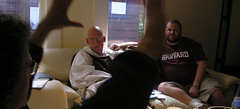Land, Water, and Participation Restored: A Report on the Work So Far
Two years ago, I argued that little was
known about the last century and a half of international movements to reform
property law for governing land and water.
Over the period of research supported by a grant at Harvard, I wrote three out
of the five chapters for my next manuscript, including chapters on finance
capitalism and the rise of the international squatters’ movement, and the rise
of participatory mapping. I presented
talks on my research at Harvard’s History Department, Land and Power
Conference, Stanford, in Sweden, and at various activist-based
conferences. The research for this
project is now complete. I collected
manuscripts at the University of Wisconsin’s Center for Land Tenure, the
Rockefeller and Ford Foundation Archives, and the University of Sussex’s
archives on the history of participation, as well as NGOs like the Center for
Environmental Studies, Praxis, and the Center for Participatory Research in
Asia in New Delhi. The bulk of the
archives I collected have been digitized and I have begun applying my digital
toolset to them, with preliminary results in the form of a heat-map of places
most frequently mentioned in the newsletters of movements for participatory
land use since 1970. This material
together forms a new manuscript, tentatively entitled, The Long Land War, which I expect to publish in 2015, covering
legal reform of property law in British Empire between 1865 and 1914; the rise
of rent strikes in Ireland and north America between 1871 and 1940;
international government and the promulgation of land reform from 1914 to 1972;
the rise of ‘informalism’ and encouragement of international squatters’
communities by the World Bank from 1945 to the present; and the birth of a
movement for the participatory mapping and governance of land and water, from
1968 till now.
As promised, a great deal of my focus was in
pioneering new tactics for digital history, where the historian would work with
unprecedented numbers of documents, applying the new tools of digital history
to their reading and analysis. I worked
with Matthew Battles at the Harvard Metalab to begin designing the toolkit, and
with help from a Google Summer of Code grant, we recruited Christopher
Johnson-Roberson to the project as its major developer. In the summer of 2012, Christopher and I
released Paper Machines, a plugin for historians’ archival materials
organization database Zotero, which allows scholars to automatically generate
timelines, maps, wordclouds, and comparative charts of topic frequency in
different collections of text. It is a
machine of unprecedented simplicity for historically analyzing large collections
of text. It has generated a great deal
of enthusiasm, at the Chronicle of Higher
Education as well as on the twitterverse and blogosphere. I currently use Paper Machines along with the
scholarly database generated by archival research supported by the Milton in my
lecture courses and graduate training at Brown University, where the software
serves to introduce my students to digital history and to crowdsource the
problem of analyzing the data generated by the archives, thus turning my
students into collaborators in the creation of new knowledge about the history
of property, law, and housing.
Reflections on the power of digital research
to extend historical accounts over longer periods of time is now an article
coauthored with Harvard historian David Armitage forthcoming in the French
journal Annales, to be extended into
a book on longue-duree history, forthcoming later this year from Cambridge
University Press. I delivered talks
about Paper Machines at the MITH seminars in the digital humanities at the
University of Maryland, at the HUMLab digital humanities lab at the Umea
University and Gothenberg University in Sweden, at Brown’s Computer Science
Department, at Stanford University’s Spatial Humanities Lab, and
elsewhere.
I wrote the grant to support informal visits
to colleagues in other fields. This
support proved absolutely essential for continuing conversations across the
borders of history and computer science.
Grants that support informal visits are rare. But hanging-out money is incredibly precious to the researcher: it means dinners out, lunches plumbing one's RA's for ideas, and trips to see colleagues in other departments on a whim. Much of the astonishing productivity of the Milton Grant was due to the committee's open-mindedness in supporting such an informal (and ambitious) proposal, one that not only named a dozen archives to visit but also named a dozen digital humanists I wanted to visit just to talk to them.
As a result of this generous room for informal networking and conversation, the Milton project has also spun off many unforeseen opportunities for research collaboration. For example, I returned from collecting archival material about the history of participatory mapping in India to meet up with colleagues in engineering, who were immediately enthused about what they heard about participatory maps as tools for democratically governing air, land, and water. Those conversations have already generated material for a series of collaborative grants to the National Science Foundation, wherein we propose to continue the historical analysis of the successes and failures of the 30-year participatory mapping movement as a way of informing best practices for the use of crowdsourced mapping platforms like Ushahidi or Google Maps for governing urban pollution and land and water use in an era of climate change. Conversations such as these would have been nearly impossible without the generous support for conversations and meetings provided by the Milton Fund.
New websites associated with the Milton Fund:
Video associated with the project:
“Can Participatory Maps Save
the World?” http://www.youtube.com/watch?v=tYL4pVUW7Lg
“Global Finance and the Rise of an
International Squatter Culture,” http://thelonglandwar.com/international-finance-and-the-rise-of-an-international-squatter-culture-1946-2012/
“Human Infrastructure,” http://thelonglandwar.com/video-human-infrastructure/
“Topic
modeling and Paper Machines”: http://vimeo.com/53078693










0 Comments:
Post a Comment
<< Home